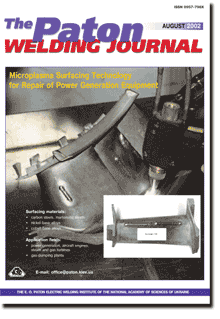

| SCIENTIFIC AND TECHNICAL | |
| Makhnenko V.I., Velikoivanenko E.A., Makhnenko O.V., Rozynka G.F., Pivtorak N.I., Seyffarth P. and Bautzmann K. Computer program "Welding of tubes to tube sheets of heat exchangers" | 2 |
| The computer program is described, and its capabilities are shown in terms of estimation of both local phenomena related to welding of individual tubes (cooling rate, microstructural changes, residual stresses) and total distortions of the tube sheet depending upon properties of materials, geometric sizes, type of a joint and sequence of welding tubes to the tube sheet. | |
| Karkhin V.A., Ploshikhin V.V. and Bergman Kh.V. Simulation of thermal and solidification processes in laser welding of aluminium plates. | 10 |
| The paper deals with the method of solving an inverse quasi-stationary problem of heat conductivity to determine the parameters of laser welding mode by measured (specified) characteristics of the weld. The objective function is taken to be the sum of weighted squares of the differences of calculated and assigned characteristics of the weld and magnitudes of the sought parameters, as well as regularisation terms. Effective (input) energy is determined by the measured weld width and angle of crystallographic orientation of weld metal grains in laser welding of an aluminium alloy. Influence of welding mode on weld pool shape and weld metal microstructure is demonstrated. | |
| Korinets I.F. and Ji Cheng Chung. Effect of gap on sizes of butt weld in consumable electrode arc welding in Ar + 25 % CO2 mixture. | 15 |
| Dependence of weld shape on gap value in consumable electrode arc welding in Ar + 25 % CO2 mixture of a square butt joint was established and a deterministic-statistical model of weld shape with allowance for a gap effect was developed. The developed model is recommended for use in the design of software of the system of adaptive control of arc welding of butt joints with a non-stable gap. | |
| Varukha E.N. and Morozov A.A. Calculation of penetration depth of workpieces in CO2 welding. | 18 |
| Non-linear model of penetration of a workpiece, describing the dependence of depth of penetration on parameters of process of mechanized welding and surfacing in CO2 at reverse polarity current is presented. | |
| Kuskov Yu.M., Ryabtsev I.I., Doroshenko L.K. and Vasiliev V.G. Peculiarities of melting and solidification of 20KhGS type deposited metal alloyed with phosphorus. | 21 |
| Processes of melting and solidification of deposited metal of 20KhGS type alloyed with 0.1--2.4 % of phosphorus were investigated using a method of a differential thermal analysis. It was established that phosphide eutectics, being hazardous from the point of view of susceptibility to hot cracks, are appeared in the deposited metal of this type at phosphorus content of more than 1 %. | |
| Tunik A.Yu. Thermal coatings containing dry lubricants for operation under conditions of dry friction and elevated temperatures | 24 |
| Results of investigation of composite powders with dry lubricants of FeCr-TiC-Mo-C and Cr2O3 -TiO2-CaF2 systems, as well as thermal coatings of a tribotechnical purpose, are presented. Conditions of thermal spraying are defined, providing dense coatings with a high adhesion and cohesion strength at a sufficiently uniform distribution of a dry lubricant across the section. | |
| INDUSTRIAL | |
| Kireev L.S. and Zamkov V.N. Fusion welding of titanium to steel (Review). | 28 |
| Literature on fusion welding of titanium to steel by the electron beam and argon-arc tungsten-electrode methods is reviewed. It is shown that titanium cannot be directly joined to steel due to formation of brittle intermetallic phases. Therefore, the technology was suggested for joining these materials through intermediate barrier inserts. The use of intermediate inserts can be avoided by joining titanium to steel in a solid-liquid state. This joining is performed by projection resistance welding with programmed internal splashing and subsequent forging of the joining zone. | |
| Tsygan B.G., Pirogov L.I., Donchenko A.V. and Trubachev Yu.A. Integrated mechanisation and automation of manufacture of welded hopper cars. | 30 |
| The paper deals with advanced technological processes to manufacture welded metal structures of hopper cars, as well as process equipment, used for their implementation. Mechanisation and automation of the most labour-consuming operations allows a significant improvement of labour efficiency and reduction of the costs, which are related to manufacture of the cars. The described designs of process equipment may be widely used in many mechanical engineering plants during performance of assembly-welding operations. | |
| BRIEF INFORMATION | |
| Chervyakov N.O. and Yushchenko K.A. Method for investigation of longitudinal residual stresses in bead on nickel alloy plate welding. | 38 |
| It is shown that maximum longitudinal tensile stresses induced in bead on nickel alloy plate welding amount to yield stress of the base metal. In the case of welding with preheating to 900 oC residual stresses decrease by 30 %. | |
| Chernyak Ya.P., Bursky G.V. and Kalensky V.K. Some peculiarities of delayed fracture of HAZ metal in steel M76 after cladding using austenitic wire. | 40 |
| Increase in heat input in cladding samples of steel M76 using wire of the PP-Np-06G13Kh13N2MF type has been found to cause increase in the HAZ metal fracture energy. Accordingly, this leads to increase in resistance of the HAZ metal to cold cracking. | |
(You are viewing the simplified file contents)
